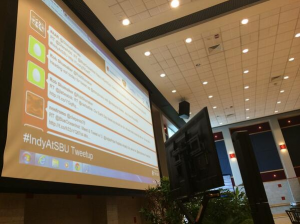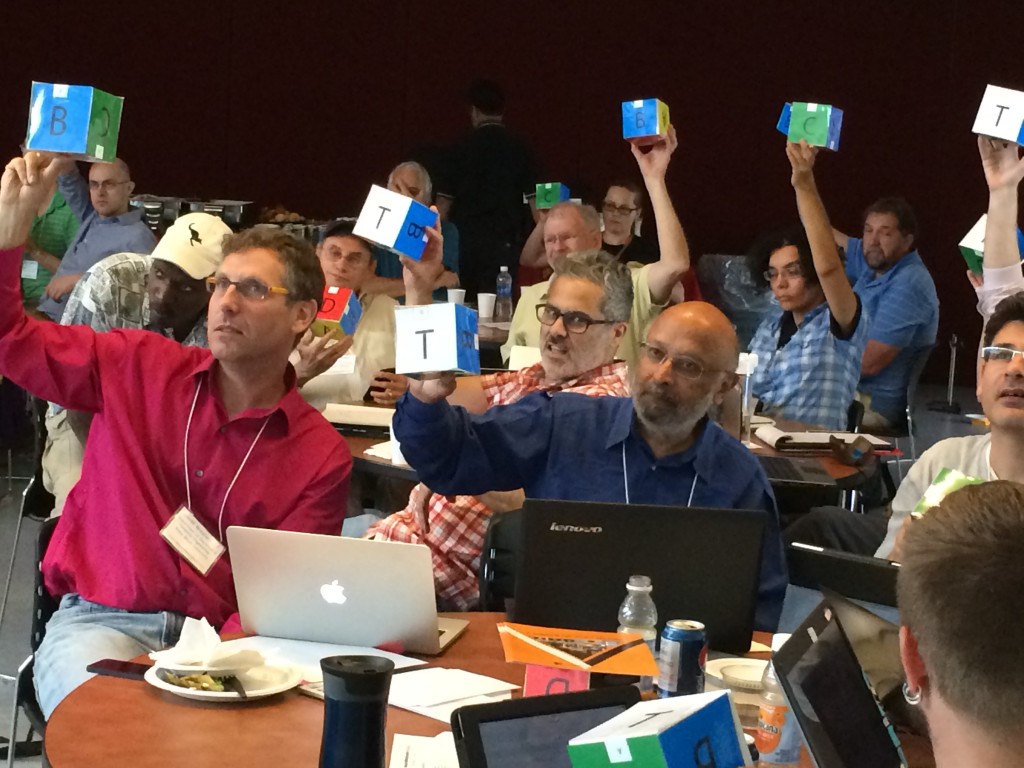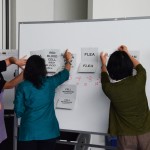
on location in SAC A setting up
Meet and Tweet with Three Wildlife Conservation Heroes
Conservationists Russell Mittermeier, Carl Safina and Patricia Wright work all around the globe, but one place unites them all:
Stony Brook University
These faculty are three of six finalists for the 2014 Indianapolis Prize, the world’s leading award for animal conservation.
Please join Stony Brook University President Samuel L. Stanley Jr., MD, as he opens this historic, interactive Earthstock event. Don’t miss theopportunity to meet and tweet alongside three of the most important and heroic wildlife conservationists of our time at the#IndyAtSBU tweetup.
Mingling and refreshments afterward.
TUESDAY, APRIL 22, 2014
Noon to 1:30 pm
STUDENT ACTIVITIES CENTER BALLROOM A • STONY BROOK UNIVERSITY
FREE AND OPEN TO THE PUBLIC
Register in advance to attend in person (form)
To follow and join the conversation go to #IndyAtSBU via Twubs
About Stony Brook University’s Indianapolis Prize Finalists
 RUSSELL A. MITTERMEIER, PhD,@RussMittermeier @ConservationOrg, is the president of Conservation International and an adjunct professor in the Department of Anatomical Sciences. He has been nominated for his efforts to understand and educate others about the worldwide threats to biodiversity, his global efforts to conserve primates, and his work to create protected areas in some of the world’s highest priority hotspots.
RUSSELL A. MITTERMEIER, PhD,@RussMittermeier @ConservationOrg, is the president of Conservation International and an adjunct professor in the Department of Anatomical Sciences. He has been nominated for his efforts to understand and educate others about the worldwide threats to biodiversity, his global efforts to conserve primates, and his work to create protected areas in some of the world’s highest priority hotspots.
 CARL SAFINA, PhD,@carlsafina, @BlueOceanInst, is a research professor in the School of Marine and Atmospheric Sciences and a visiting professor and board member of the Alan Alda Center for Communicating Science. Founder of Blue Ocean Institute and known as the “voice of ocean conservation,” he has been sounding the alarm for the preservation of marine animals and the oceans that house them.
CARL SAFINA, PhD,@carlsafina, @BlueOceanInst, is a research professor in the School of Marine and Atmospheric Sciences and a visiting professor and board member of the Alan Alda Center for Communicating Science. Founder of Blue Ocean Institute and known as the “voice of ocean conservation,” he has been sounding the alarm for the preservation of marine animals and the oceans that house them.
 PATRICIA WRIGHT, PhD,@patcwright, is the founding director of Centre ValBio and the Institute for the Conservation of Tropical Environments and a professor of anthropology. She has been recognized for her tireless work with lemurs in Madagascar, including the development of Ranomafana National Park, the home of 12 lemur species, some of which are listed among the world’s most endangered animals.
PATRICIA WRIGHT, PhD,@patcwright, is the founding director of Centre ValBio and the Institute for the Conservation of Tropical Environments and a professor of anthropology. She has been recognized for her tireless work with lemurs in Madagascar, including the development of Ranomafana National Park, the home of 12 lemur species, some of which are listed among the world’s most endangered animals.
Representing the Indianapolis Prize
 ROBERT SHUMAKER, PhD, @IndplsPrize, is Vice President of Life Sciences at the Indianapolis Zoo, which administers the Indianapolis Prize. He is internationally recognized as a leading expert on orangutan behavior and cognition. He’s been a faculty member at George Mason University and Drake University. Dr. Shumaker started his career at the Smithsonian National Zoo and also served as the senior scientist at the Great Ape Trust in Des Moines, Iowa.
ROBERT SHUMAKER, PhD, @IndplsPrize, is Vice President of Life Sciences at the Indianapolis Zoo, which administers the Indianapolis Prize. He is internationally recognized as a leading expert on orangutan behavior and cognition. He’s been a faculty member at George Mason University and Drake University. Dr. Shumaker started his career at the Smithsonian National Zoo and also served as the senior scientist at the Great Ape Trust in Des Moines, Iowa.

Like this:
Like Loading...











 RUSSELL A. MITTERMEIER, PhD,@RussMittermeier @ConservationOrg, is the president of Conservation International and an adjunct professor in the Department of Anatomical Sciences. He has been nominated for his efforts to understand and educate others about the worldwide threats to biodiversity, his global efforts to conserve primates, and his work to create protected areas in some of the world’s highest priority hotspots.
RUSSELL A. MITTERMEIER, PhD,@RussMittermeier @ConservationOrg, is the president of Conservation International and an adjunct professor in the Department of Anatomical Sciences. He has been nominated for his efforts to understand and educate others about the worldwide threats to biodiversity, his global efforts to conserve primates, and his work to create protected areas in some of the world’s highest priority hotspots. CARL SAFINA, PhD,@carlsafina, @BlueOceanInst, is a research professor in the School of Marine and Atmospheric Sciences and a visiting professor and board member of the Alan Alda Center for Communicating Science. Founder of Blue Ocean Institute and known as the “voice of ocean conservation,” he has been sounding the alarm for the preservation of marine animals and the oceans that house them.
CARL SAFINA, PhD,@carlsafina, @BlueOceanInst, is a research professor in the School of Marine and Atmospheric Sciences and a visiting professor and board member of the Alan Alda Center for Communicating Science. Founder of Blue Ocean Institute and known as the “voice of ocean conservation,” he has been sounding the alarm for the preservation of marine animals and the oceans that house them. PATRICIA WRIGHT, PhD,@patcwright, is the founding director of Centre ValBio and the Institute for the Conservation of Tropical Environments and a professor of anthropology. She has been recognized for her tireless work with lemurs in Madagascar, including the development of Ranomafana National Park, the home of 12 lemur species, some of which are listed among the world’s most endangered animals.
PATRICIA WRIGHT, PhD,@patcwright, is the founding director of Centre ValBio and the Institute for the Conservation of Tropical Environments and a professor of anthropology. She has been recognized for her tireless work with lemurs in Madagascar, including the development of Ranomafana National Park, the home of 12 lemur species, some of which are listed among the world’s most endangered animals. ROBERT SHUMAKER, PhD, @IndplsPrize, is Vice President of Life Sciences at the Indianapolis Zoo, which administers the Indianapolis Prize. He is internationally recognized as a leading expert on orangutan behavior and cognition. He’s been a faculty member at George Mason University and Drake University. Dr. Shumaker started his career at the Smithsonian National Zoo and also served as the senior scientist at the Great Ape Trust in Des Moines, Iowa.
ROBERT SHUMAKER, PhD, @IndplsPrize, is Vice President of Life Sciences at the Indianapolis Zoo, which administers the Indianapolis Prize. He is internationally recognized as a leading expert on orangutan behavior and cognition. He’s been a faculty member at George Mason University and Drake University. Dr. Shumaker started his career at the Smithsonian National Zoo and also served as the senior scientist at the Great Ape Trust in Des Moines, Iowa.